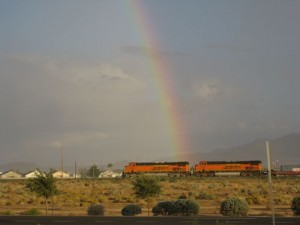WATER IN THE DESERT, KINGMAN, ARIZ., EDITION
Posted on | October 16, 2010 | No Comments
KINGMAN, ARIZ. – I made a beeline across two states today, heading for Lake Mead to watch history happen.
It looks as though sometime tomorrow (Sun. 10/17/2010) or Monday, depending on the weather and releases from Hoover Dam for power generation and downstream water users, the surface level of Lake Mead will drop below 1083.19 feet, its low point during drought of the 1950s. As I write this Saturday evening, it’s less than an inch away.
I made it as far as Kingman by sunset, and after checking into my motel grabbed some fast food and headed to a city park. By the time I got there it was pouring, so I hunkered down in the shelter of a utility building and watched. It had the feel of a summer thunderstorm even though it’s mid-October, with thrashing winds, thunder and lightning. It’s fall enough that the wind was blowing leaves off the trees, and my feet got wet and cold (I was wearing sandals). But it was lovely nonetheless. There is a joy to being in the desert in a downpour. As I drove back to the motel, gutters were running full, and kids were splashing.
On the drive over, across northern Arizona, you could still see big patches of piñon pine that died in the drought of 2002-2003.
Tom Yulsman has an excellent post today on the what’s and why’s of Lake Mead’s situation, to which I don’t have a lot to add. Well, OK, I have a lot to add, enough to write a book, but there will be time enough for that. For now, head over to Tom’s place for an explanation of our big dry, with the money quote from Brad Udall:
. . . what you’re really seeing here is a combination of drought and an overuse problem amongst the three three lower basin states of California, Nevada and Arizona. And that overuse problem historically has been covered up by a little extra water that flows down from Colorado and the upper basin states. But over the last 11 years, with the most serious drought on record, that water hasn’t been there, and so the overuse problem has become readily apparent.
It’s worth noting that the variables that will determine when we drop below that 1950s low are weather and downstream use – how much water nature provides and how we decide to use it. Drought in this sense is very much a human phenomenon.
The response to the convergence of those problems is the 2007 shortage sharing agreement among the lower basin states. It’s a remarkable thing, a set of guidelines to do something that has never been needed before in a century of industrialized development of the Colorado River – to use less water.
One of the reasons I’m heading to Hoover Dam, Lake Mead and Las Vegas is to learn more about how the shortage sharing agreement was developed, and how it will work in practice. I’m increasingly dissatisfied with the “OMG we’re screwed” narrative. I’m trying to understand the institutional frameworks that have allowed us to go through the 11 driest years on record without anyone’s water being cut off, and to further understand what happens during year 12, which seems to have a good chance of happening in 2011.
In the time I’ve been writing this, Lake Mead dropped another 1/8th of an inch.








No comments:
Post a Comment